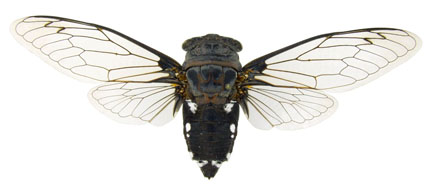

Cornuplura nigroalbata (Arizona)
** SONGS AND IMAGES MAY NOT BE REPRODUCED ELSEWHERE. SEE THE COPYRIGHT SECTION **
This website is intended to provide song recordings, and eventually photos and maps, of many of the cicada species of the western United States and Canada. The 100th meridian is used here as an arbitrary divider between east and west, which contain quite different faunas. Currently, the taxonomic content of the page emphasizes the species found in the Great Plains and Southwestern regions – we have not yet recorded many of the species in the genera Platypedia and Okanagana. Cicada song recordings for the species of the eastern United States and Canada can be found here. Distribution maps based on museum specimen records can be found in Sanborn and Phillips (2013). Cicada diversity is the western United States and Canada is higher than in the east. Twelve genera are found in the west, including eight that do not extend very far east of the 100th meridian (Cacama, Clidophleps, Cornuplura, Hadoa, Platypedia, Neoplatypedia, Okanagodes, and Tibicinoides). |
 |
| Western species in the genera Cacama, Cornuplura, Hadoa, and Megatibicen belong to the tribe Cryptotympanini, and they call from trees, Yucca, cactus, or sometimes prairie plants. Most of these western species are patterned with greys, blacks and browns, but some have conspicuous spots of white wax. All of the species in Hadoa, Megatibicen, and Neotibicen were recently moved from the genus Tibicen, because they are unrelated to the European type of that genus. See Hill et al. 2015 for more information. Some species of the eastern cryptotympanine genus Neotibicen also extend into the western Great Plains. | 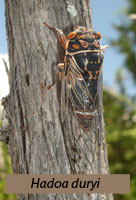 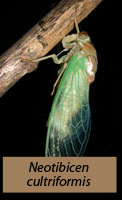 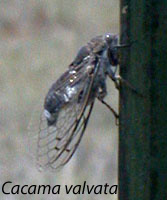 |
| The genera Platypedia and Neoplatypedia are entirely restricted to the western half of the USA, but species of Platypedia are distributed all the way south to South America. These genera have lost their timbals and sing entirely by clicking or buzzing their wings and you can sometimes encourage Platypedia to click by clicking two coins together. There are many species of Platypedia but we have only collected a few of them. Most species are black with small brown, orange, red or white markings, and are sometimes very furry. They are quite small cicadas and sing from trees or shrubs. | 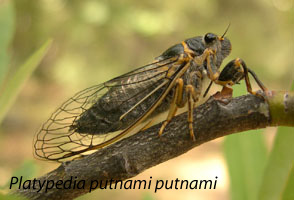 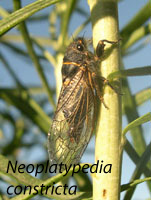 |
| There are a number of species of Diceroprocta in the southwestern states, and some, such as D. apache, are quite large. They call from trees or sometimes shrubs and often sit with the head pushed away from their perch and the wings held down along the side of the branch they are sitting on. There are also many Diceroprocta in Mexico. | 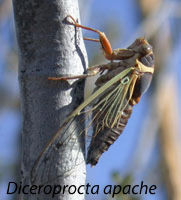 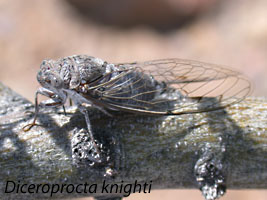 |
| Clidophleps, Okanagana, Okanagodes, and Tibicinoides are in the tribe Tibicinini (see Marshall et al., 2018). There are many, many species of Okanagana in the western USA and Canada, but we have not collected very many. They call from trees and shrubs. Most Okanagana are black with brown, red, orange or white markings, but the odd one is patterned with green or solid pale green, tan or yellow. Most are medium sized cicadas with continuous, whiny or lispy songs. Okanagodes sing from low down on small desert plants in the intense heat of the day. They are pale green or pale tan with a very large postclypeus ("nose"). Clidophleps vagans also calls from low on small shrubs in desert areas. | 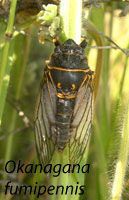 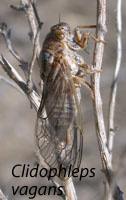 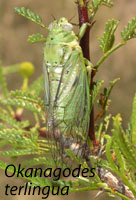 |
References: Author and date information are given below for all taxonomic units. These references will be included in a Literature Cited page here, but for now they can be found at the comprehensive Bibliography of the Cicadoidea website.
SUBFAMILY CICADINAE Latreille, 1802
Genus Beameria Davis, 1934 |
SONG (MP3 - CLICK LINK) |
PHOTOS NOT READY YET |
MAPS NOT READY YET |
COMMENTS |
Beameria venosa (Uhler, 1888) |
 |
 |
|
|
Beameria wheeleri Davis, 1934 |
SONG |  |
 |
|
Genus Cacama Distant, 1904 |
SONG (MP3 - CLICK LINK) |
PHOTOS NOT READY YET |
MAPS NOT READY YET |
COMMENTS |
Cacama valvata (Uhler, 1888) |
SONG |  |
 |
|
Genus Cornuplura Davis, 1944 |
SONG (MP3 - CLICK LINK) |
PHOTOS NOT READY YET |
MAPS NOT READY YET |
COMMENTS |
Cornuplura nigroalbata (Davis, 1936) |
SONG |  |
 |
|
Genus Diceroprocta Stål, 1870 |
SONG (MP3 - CLICK LINK) |
PHOTOS NOT READY YET |
MAPS NOT READY YET |
COMMENTS |
Diceroprocta apache Davis, 1921 |
SONG |  |
 |
|
Diceroprocta arizona Davis, 1916 |
SONG |  |
 |
|
Diceroprocta aurantiaca Davis, 1938 |
 |
 |
|
|
Diceroprocta azteca (Kirkaldy, 1881) |
 |
 |
|
|
Diceroprocta cinctifera (Uhler, 1892) |
SONG |  |
 |
|
Diceroprocta delicata (Osborn, 1906) |
 |
 |
|
|
Diceroprocta eugraphica (Davis, 1916) |
 |
 |
|
|
Diceroprocta knighti (Davis, 1917) |
SONG |  |
 |
|
Diceroprocta semicincta (Davis, 1925) |
SONG |  |
 |
|
Diceroprocta swalei (Distant, 1904) |
SONG |  |
 |
|
Diceroprocta texana texana (Davis, 1916) |
 |
 |
|
Genus Hadoa Moulds, 2015 |
SONG (MP3 - CLICK LINK) |
PHOTOS NOT READY YET |
MAPS NOT READY YET |
COMMENTS |
Hadoa bifida (Davis, 1926) |
 |
 |
|
|
Hadoa chiricahua (Davis, 1923) |
SONG |  |
 |
|
Hadoa duryi (Davis, 1917) |
SONG |  |
 |
|
Hadoa inaudita (Davis, 1917) |
SONG |  |
 |
|
Hadoa longiopercula (Davis, 1926) |
SONG |  |
 |
|
Hadoa parallela (Davis, 1923) |
SONG |  |
 |
|
Hadoa simplex (Davis, 1941) |
 |
 |
|
|
Hadoa texana (Metcalf, 1963) (=T. tigrinus Davis, 1927) |
 |
 |
|
|
Hadoa townsendii (Uhler, 1905) |  |
 |
|
Genus Neocicada Kato, 1932 |
SONG (MP3 - CLICK LINK) |
PHOTOS NOT READY YET |
MAPS NOT READY YET |
COMMENTS |
Neocicada chisos Davis, 1916 |
SONG |  |
 |
|
Genus Megatibicen Sanborn and Heath, 2016 |
SONG (MP3 - CLICK LINK) |
PHOTOS NOT READY YET |
MAPS NOT READY YET |
COMMENTS |
Megatibicen cultriformis (Davis, 1915) |
SONG |  |
 |
|
Megatibicen dealbatus (Davis, 1915) |
 |
 |
|
|
Megatibicen dorsatus (Say, 1825) |
 |
 |
|
|
Megatibicen harenosus Cole, 2017 |
 |
 |
|
|
Megatibicen pronotalis pronotalis (Davis, 1938) |
 |
 |
|
|
Megatibicen tremulus (Cole, 2008) |
 |
 |
|
Genus Neotibicen Hill and Moulds, 2015 |
SONG (MP3 - CLICK LINK) |
PHOTOS NOT READY YET |
MAPS NOT READY YET |
COMMENTS |
Neotibicen pruinosus (Say, 1925) |
 |
 |
|
|
Neotibicen superbus (Fitch, 1855) |
 |
 |
|
Genus Pacarina Distant, 1905 |
SONG (MP3 - CLICK LINK) |
PHOTOS NOT READY YET | MAPS NOT READY YET | COMMENTS |
Pacarina puella Davis, 1923 (= "Cicada signifera" Walker 1858) |
 |
 |
|
Genus Quesada Distant, 1905 |
SONG (MP3 - CLICK LINK) |
PHOTOS NOT READY YET | MAPS NOT READY YET | COMMENTS |
Quesada gigas (Olivier, 1790) |
 |
 |
|
SUBFAMILY TETTIGADINAE Distant, 1905
Genus Clidophleps Van Duzee, 1915 |
SONG (MP3 - CLICK LINK) |
PHOTOS NOT READY YET |
MAPS NOT READY YET |
COMMENTS |
Clidophleps vagans Davis, 1925 |
SONG |  |
 |
|
Genus Neoplatypedia Davis, 1920 |
SONG (MP3 - CLICK LINK) |
PHOTOS NOT READY YET |
MAPS NOT READY YET |
COMMENTS |
Neoplatypedia constricta Davis, 1920 |
SONG |  |
 |
|
Genus Okanagana Distant, 1905 |
SONG (MP3 - CLICK LINK) |
PHOTOS NOT READY YET |
MAPS NOT READY YET |
COMMENTS |
Okanagana balli Davis 1919 |
 |
 |
|
|
Okanagana bella bella Davis, 1919 |
SONG |  |
 |
|
Okanagana bella rubrocaudata Davis, 1925 |
SONG |  |
 |
|
Okanagana canadensis (Provancher, 1889) |
 |
 |
|
|
Okanagana bella bella Davis, 1919 |
SONG |  |
 |
|
Okanagana bella rubrocaudata Davis, 1925 |
SONG |  |
 |
|
Okanagana fumipennis Davis, 1932 |
SONG |  |
 |
|
Okanagana hesperia (Uhler, 1876) sometimes listed as Tibicinoides hesperia |
SONG |  |
 |
|
Okanagana rimosa rimosa (Say, 1830) |
 |
 |
|
|
Okanagana rubrovenosa rubida Davis, 1936 |
SONG |  |
 |
|
Okanagana rubrovenosa rubrovenosa Davis, 1915 |
SONG |  |
 |
|
Okanagana synodica Say, 1825 |
 |
 |
|
|
Okanagana utahensis Davis, 1919 |
SONG |  |
 |
|
Okanagana vanduzeei Distant, 1914 |
SONG |  |
 |
|
Genus Okanagodes Davis, 1919 |
SONG (MP3 - CLICK LINK) |
PHOTOS NOT READY YET |
MAPS NOT READY YET |
COMMENTS |
Okanagodes gracilis Davis, 1919 |
SONG |  |
 |
|
Okanagodes terlingua Davis, 1932 |
SONG |  |
 |
|
Genus Platypedia Uhler, 1888 |
SONG (MP3 - CLICK LINK) |
PHOTOS NOT READY YET |
MAPS NOT READY YET |
COMMENTS |
Platypedia putnami (Uhler 1877) |
SONG |  |
 |
|
Platypedia similis Davis,1920 |
SONG |  |
 |
|
SUBFAMILY CICADETTINAE Buckton, 1809
Genus Cicadettana Marshall & Hill, 2017 |
SONG (MP3 - CLICK LINK) |
PHOTOS NOT READY YET | MAPS NOT READY YET | COMMENTS |
Cicadettana calliope calliope (Walker, 1850) |
 |
 |
|
|
Cicadettana kansa (Davis, 1919) |
 |
 |
|
Methods Notes
The recordings on this page were made by the authors using a variety of digital audio recorders (e.g., SONY TCD-D8 DAT, Marantz PMD 660, 670, or 680 compact flash models) sampling at either 44.1 or 48 kHz. Microphones used were Sennheiser ME62 omnidirectional microphones installed in SONY PBR-330 parabolic reflectors, or similar-quality Sennheiser short- and long-gun shotgun mikes with no parabola. (Note that parabolic reflectors introduce small "pre-click" artifacts because sound waves are recorded twice, once weakly as they arrive and then again after reflection, but these are noticeable only during very fine-scale analysis.) Files were processed (e.g., filtering) using Canary or RavenPro v1.4 software (Cornell Bioacoustics) on Macintosh G3, G4 and intel computers, and the 128 Mbps, constant-bitrate MP3 files were generated using open-source Audacity 1.3.12-beta software.
These examples have been selected because they represent the typical song behavior as well as possible given what we have in our archives.
Most of the recordings have been filtered to remove sound below around 4 kHz, where most automobile, wind, and other environmental noise is found. In a few cases frequencies higher than those of the target cicada have been removed, for example when a loud katydid overlapped the song of the target. Some of the recordings have a "tinny" feel as a result of this filtering.
Many of the sound files have also been modified with "fade in" and "fade out" effects, especially when the song of the cicada is not structured into distinct phrases.
The sound and image files linked on this site are for personal, not-for-profit viewing and listening only and must not be duplicated, sold, or reproduced elsewhere without written permission from David Marshall [cicada "at" insectsingers.com]. Nonetheless, we're usually happy to oblige requests for educational purposes and limited use in other projects.
Other Websites on Cicadas and Singing Insects
Cicadamania – the oldest and best-known general website for cicada enthusiasts.
Magicicada.org – established to solicit and organize distribution records for periodical cicada broods from the public.
Cicada Central – established as a clearinghouse for research on world Cicadidae.
New Zealand Cicadas: A Virtual Identification Guide – comprehensive information on the New Zealand species.
Cicadas of Australia – an extensive website on Australian cicadas, with songs, photos, maps, and natural history.
The Canadian National Collection of Insects – general cicada identification plus information on morphology, ecology, and evolution.
Cicadasong.eu – songs and other content on European cicadas.
Cicadas of India – a major new addition with over 100 species pages.
Cicadidae in Japan – includes a database form for accessing songs of Japanese and Korean cicadas.
Slovenian Wildlife Sound Archive – from the Slovenian Museum of Natural History.
S.E. Asian Cicada Songs – from the Slovenian Museum of Natural History.
Cicada Songs from Borneo – with sonograms and some phenological data.
Checklist of South African Cicadas – from the Villet Lab, Rhodes University.
Great Lakes Cicada Page – by the author of a new book "The Season of the Cicada".
Cicadas.info – focuses on cicadas of the mid-Atlantic states.
Cicadas of Massachusetts – extensive site on New England cicadas, collecting techniques, etc.
Cicadas of Michigan – focuses on Michigan cicadas with songs and identification keys.
Cicadas of Florida – basic taxonomy, identification, and life history.
Cicada Checklist of Texas – includes detailed information on Quesada gigas
University of Michigan Periodical Cicada Site – older comprehensive site on periodical cicadas.
BugGuide.net – a general insect identification site with many cicada photos; some photo IDs may not be correct.
Songs of Insects – a companion website for a book of the same name, contains an online identification guide for songs.
Singing Insects of North America – an extensive general resource with songs, maps, and keys. Cicada section under development.
Bibliography of the Cicadoidea – a web database of scientific publications on cicadas.
Credits and Acknowledgments
Website constructed by David C. Marshall and Kathy Hill, researchers at the University of Connecticut in the lab of Chris Simon. This research has benefited from substantial synergistic support under NSF grants DEB 04-22386, DEB 05-29679, and DEB 07-20664 to Chris Simon and from discussions with many cicada enthusiasts and collaborators.
Go to Cicadas of the United States and Canada East of the 100th Meridian
Back to InsectSingers.com